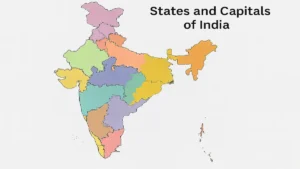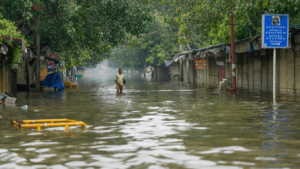A dam is a physical obstruction that slows or restricts the flow of subsurface or surface water. Dams build reservoirs that serve multiple purposes, including flood control, irrigation, human consumption, industrial use, aquaculture, and navigability. Dams and hydropower are frequently combined to produce electricity. Water that can be equally divided between areas can be gathered or stored in a dam.
While other structures, like floodgates or levees (also known as dikes), are used to control or prohibit water flow into particular geographical zones, dams typically serve the primary function of retaining water. The Jawa Dam in Jordan dates back to 3,000 BC and is the oldest known dam.
Types of Dams in India
Here are the types of the Dams of India:
- Arch Dam: An arch dam is curved upstream and uses water pressure to strengthen its structure. It works best in narrow canyons with strong rock walls.
- Gravity Dam: A gravity dam is made of concrete or stone and relies on its weight to resist water pressure. Each part is stable and independent.
- Arch-Gravity Dam: This dam combines features of arch and gravity dams. It channels water pressure against canyon walls, reducing lateral force on the dam.
- Barrages: Barrages are low dams with large gates to control water flow. They maintain river levels for irrigation and other uses.
- Embankment Dam: An embankment dam is built from compacted soil, sand, clay, or rock. It has a solid core and a waterproof covering.
- Rock-Fill Dam: A rock-fill dam is made from compacted, granular earth with larger particles. It includes an impermeable zone to prevent water leakage.
- Concrete-Face Rock-Fill Dam: This type of dam has concrete slabs on its upstream face, providing an impervious barrier while minimizing uplift pressure.
- Earth-Fill Dam: Earth-fill dams, also called earthen dams, are made from well-compacted soil. They may have layers to manage water leaks.
Highest Dam in India: Tehri Dam(Uttarakhand)
- The Tehri Dam is the tallest dam in India and ranks 12th in the world in terms of height with a height of 260.5 m (855 ft).
- It is India’s largest hydroelectric power project, with a total planned installed capacity of 2400 MW.
- It is a multi-use rock and earth-fill embankment dam on the Bhagirathi River in the Indian state of Uttarakhand’s Tehri Garhwal district.
- It serves as the main dam for both the Tehri hydropower complex and THDC India Ltd.
- The first stage was finished in 2006.
- A reservoir for agriculture, urban water supply, and the production of 1,000 megawatts (1,300,000 hp) of hydroelectricity is kept in place by the Tehri Dam.
- The 1,000 MW variable-speed pumped-storage system for the dam is currently being built, with the first two units projected to be operational in 2023.
Longest Dam in India: Hirakud Dam (Odisha)
- In the Indian state of Odisha, Hirakud Dam is situated across the Mahanadi River, roughly 15 kilometres (9 miles) from Sambalpur.
- It is the world’s longest earthen dam.
- The 55 km (34 km) long Hirakud Reservoir is a lake that stretches behind the dam.
- One of the earliest significant multipurpose river valley projects to be undertaken in India since its independence.
- On October 12, 2021, Hirakud Reservoir was designated as a Ramsar site.
Oldest Dam in India: Kallanai Dam (Tamil Nadu)
- Kallanai, often referred to as the Grand Anicut, is a historic dam that was constructed in 150 CE by Karikala of the Chola dynasty.
- It is constructed (in running water) spanning the Kaveri River in Tamil Nadu, India, which runs from Tiruchirapalli District to Thanjavur District.
- The district of Thanjavur contains the dam. situated 45 kilometres from Tanjavur and 15 kilometres from Tiruchirapalli.
- The oldest in India that is still in use, it is the fourth-oldest water diversion or water-regulator structure in the entire globe.
- It is one of the most popular tourist destinations in Tamil Nadu due to its magnificent architecture.
List of Important Dams in India
India has numerous important dams that play a vital role in irrigation, water supply, and hydroelectric power generation. These structures help manage water resources, support agriculture, and provide energy, making them crucial for the country’s development and sustainability.
Following is the list of Important Dams in India:
| Important Dams in India | State of Important Dam in India | River |
| Bhavani Sagar dam | Tamil Nadu | Bhavani |
| Tungabhadra Dam | Karnataka | Tungabhadra |
| Rihand Dam | Uttar Pradesh | Rihand |
| Maithon Dam | Jharkhand | Barakar |
| Koyna Dam | Maharashtra | Koyna |
| Bisalpur Dam | Rajasthan | Banas |
| Mettur Dam | Tamil Nadu | Kaveri |
| Krishnarajasagar Dam | Karnataka | Kaveri |
| Indira Sagar Dam | Madhya Pradesh | Narmada |
| Cheruthoni Dam | Kerala | Cheruthoni |
| Sardar Sarovar Dam | Gujarat | Narmada |
| Nagarjuna Sagar Dam | Telangana | Krishna |
| Hirakud dam | Odisha | Mahanadi |
| Bhakra Nangal Dam | Punjab-Himachal Pradesh Border | Sutlej |
| Tehri Dam | Uttarakhand | Bhagirathi |










 States and Capitals of India, Check the ...
States and Capitals of India, Check the ...
 Daily Current Affairs 16th September, 20...
Daily Current Affairs 16th September, 20...
 Top-10 Flood-Prone Cities in India 2025:...
Top-10 Flood-Prone Cities in India 2025:...

